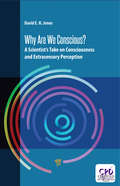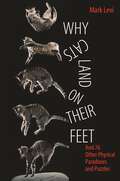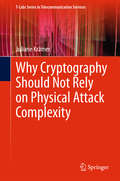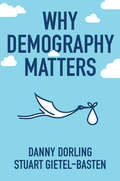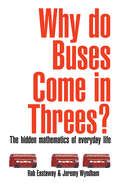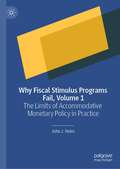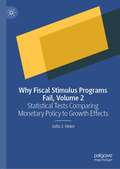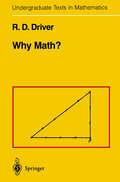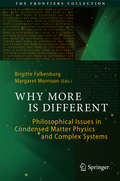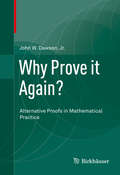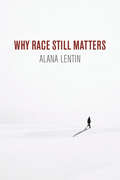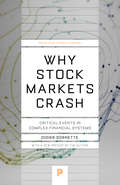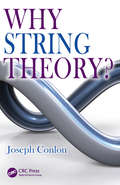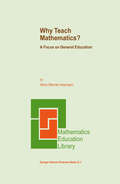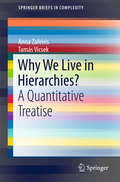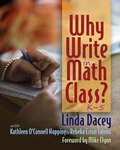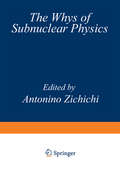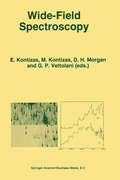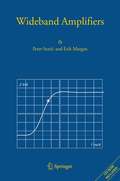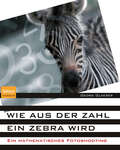- Table View
- List View
Why Are We Conscious?: A Scientist’s Take on Consciousness and Extrasensory Perception
by David E.H. JonesThere are two huge gaps in scientific theory. One, the contradiction between classical and quantum mechanics, is discussed in many publications. The other, the total failure to explain why anything made of atoms (such as ourselves) can be conscious, has little acknowledgement. The main thesis of this book is that to be conscious at all, you need an unconscious mind. The author explores the idea that this mind sometimes makes contact with a whole unknown world, sporadically revealed by paranormal effects, but perhaps discoverable by hitherto uninvented scientific instruments. The book looks at the notion of the unconscious mind, one of the most important hypotheses of the twentieth century. Psychiatrists often deploy it rather informally, but there is no accepted theory of it. No region of the human brain seems to hold it. The author delves into the notion that the unknown world exists and is very weakly coupled to the physical world. He ponders the properties it may have to allow this coupling, looks at several paranormal effects scientifically and points out that many of them seem to imply brief but dramatic changes of the forces between atoms—a possible effect of the unknown world, unexamined by physical science. No existing publication seeks to talk both about paranormal mysteries and scientific theory. If scientists know about the gaps in existing knowledge, they might initiate research into such gaps, or notice experimental oddities they now gloss over. If the general public was aware of the gaps in physical theory, they would be less overwhelmed by the intellectual diktats of some scientists.
Why Cats Land on Their Feet: And 76 Other Physical Paradoxes and Puzzles
by Mark LeviEver wonder why cats land on their feet? Or what holds a spinning top upright? Or whether it is possible to feel the Earth's rotation in an airplane? Why Cats Land on Their Feet is a compendium of paradoxes and puzzles that readers can solve using their own physical intuition. And the surprising answers to virtually all of these astonishing paradoxes can be arrived at with no formal knowledge of physics. Mark Levi introduces each physical problem, sometimes gives a hint or two, and then fully explains the solution. Here readers can test their critical-thinking skills against a whole assortment of puzzles and paradoxes involving floating and diving, sailing and gliding, gymnastics, bike riding, outer space, throwing a ball from a moving car, centrifugal force, gyroscopic motion, and, of course, falling cats. Want to figure out how to open a wine bottle with a book? Or how to compute the square root of a number using a tennis shoe and a watch? Why Cats Land on Their Feet shows you how, and all that's required is a familiarity with basic high-school mathematics. This lively collection also features an appendix that explains all physical concepts used in the book, from Newton's laws to the fundamental theorem of calculus.
Why Cats Land on Their Feet: And 76 Other Physical Paradoxes and Puzzles
by Mark LeviEver wonder why cats land on their feet? Or what holds a spinning top upright? Or whether it is possible to feel the Earth's rotation in an airplane? Why Cats Land on Their Feet is a compendium of paradoxes and puzzles that readers can solve using their own physical intuition. And the surprising answers to virtually all of these astonishing paradoxes can be arrived at with no formal knowledge of physics. Mark Levi introduces each physical problem, sometimes gives a hint or two, and then fully explains the solution. Here readers can test their critical-thinking skills against a whole assortment of puzzles and paradoxes involving floating and diving, sailing and gliding, gymnastics, bike riding, outer space, throwing a ball from a moving car, centrifugal force, gyroscopic motion, and, of course, falling cats. Want to figure out how to open a wine bottle with a book? Or how to compute the square root of a number using a tennis shoe and a watch? Why Cats Land on Their Feet shows you how, and all that's required is a familiarity with basic high-school mathematics. This lively collection also features an appendix that explains all physical concepts used in the book, from Newton's laws to the fundamental theorem of calculus.
Why Cryptography Should Not Rely on Physical Attack Complexity (T-Labs Series in Telecommunication Services)
by Juliane KrämerThis book presents two practical physical attacks. It shows how attackers can reveal the secret key of symmetric as well as asymmetric cryptographic algorithms based on these attacks, and presents countermeasures on the software and the hardware level that can help to prevent them in the future. Though their theory has been known for several years now, since neither attack has yet been successfully implemented in practice, they have generally not been considered a serious threat. In short, their physical attack complexity has been overestimated and the implied security threat has been underestimated. First, the book introduces the photonic side channel, which offers not only temporal resolution, but also the highest possible spatial resolution. Due to the high cost of its initial implementation, it has not been taken seriously. The work shows both simple and differential photonic side channel analyses. Then, it presents a fault attack against pairing-based cryptography. Due to the need for at least two independent precise faults in a single pairing computation, it has not been taken seriously either.Based on these two attacks, the book demonstrates that the assessment of physical attack complexity is error-prone, and as such cryptography should not rely on it. Cryptographic technologies have to be protected against all physical attacks, whether they have already been successfully implemented or not. The development of countermeasures does not require the successful execution of an attack but can already be carried out as soon as the principle of a side channel or a fault attack is sufficiently understood.
Why Demography Matters
by Danny Dorling Stuart Gietel-BastenDemography is not destiny. As Giacomo Casanova explained over two centuries ago: 'There is no such thing as destiny. We ourselves shape our own lives.' Today we are shaping them and our societies more than ever before. Globally, we have never had fewer children per adult: our population is about to stabilize, though we do not know when or at what number, or what will happen after that. It will be the result of billions of very private decisions influenced in turn by multiple events and policies, some more unpredictable than others. More people are moving further around the world than ever before: we too often see that as frightening, rather than as indicating greater freedom. Similarly, we too often lament greater ageing, rather than recognizing it as a tremendous human achievement with numerous benefits to which we must adapt. Demography comes to the fore most positively when we see that we have choices, when we understand variation and when we are not deterministic in our prescriptions. The study of demography has for too long been dominated by pessimism and inhuman, simplistic accounting. As this fascinating and persuasive overview demonstrates, how we understand our demography needs to change again.
Why Do Buses Come in Threes?: The Hidden Maths Of Everyday Life
by Rob EastawayWith a foreword by Tim Rice, this book will change the way you see the world. Why is it better to buy a lottery ticket on a Friday? Why are showers always too hot or too cold? And what's the connection between a rugby player taking a conversion and a tourist trying to get the best photograph of Nelson's Column?
Why Fiscal Stimulus Programs Fail, Volume 1: The Limits of Accommodative Monetary Policy in Practice
by John J. HeimThis book offers a series of statistical tests to determine if the “crowd out” problem, known to hinder the effectiveness of Keynesian economic stimulus programs, can be overcome by monetary programs. It concludes there are programs that can do this, specifically “accommodative monetary policy.” They were not used to any great extent prior to the Quantitative Easing program in 2008, causing the failure of many fiscal stimulus programs through no fault of their own. The book includes exhaustive statistical tests to prove this point. There is also a policy analysis section of the book. It examines how effectively the Federal Reserve’s anti-crowd out programs have actually worked, to the extent they were undertaken at all. It finds statistical evidence that using commercial and savings banks instead of investment banks when implementing accommodating monetary policy would have markedly improved their effectiveness. This volume, with its companion volume Why Fiscal Stimulus Programs Fail, Volume 2: Statistical Tests Comparing Monetary Policy to Growth, provides 1000 separate statistical tests on the US economy to prove these assertions.
Why Fiscal Stimulus Programs Fail, Volume 2: Statistical Tests Comparing Monetary Policy to Growth Effects
by John J. HeimThis book scientifically tests the assertion that accommodative monetary policy can eliminate the “crowd out” problem, allowing fiscal stimulus programs (such as tax cuts or increased government spending) to stimulate the economy as intended. It also tests to see if natural growth in th economy can cure the crowd out problem as well or better. The book is intended to be the largest scale scientific test ever performed on this topic. It includes about 800 separate statistical tests on the U.S. economy testing different parts or all of the period 1960 – 2010. These tests focus on whether accommodative monetary policy, which increases the pool of loanable resources, can offset the crowd out problem as well as natural growth in the economy. The book, employing the best scientific methods available to economists for this type of problem, concludes accommodate monetary policy could have, but until the quantitative easing program, Federal Reserve efforts to accommodate fiscal stimulus programs were not large enough to offset more than 23% to 44% of any one year’s crowd out problem. That provides the science part of the answer as to why accommodative monetary policy didn’t accommodate: too little of it was tried. The book also tests whether other increases in loanable funds, occurring because of natural growth in the economy or changes in the savings rate can also offset crowd out. It concludes they can, and that these changes tend to be several times as effective as accommodative monetary policy. This book’s companion volume Why Fiscal Stimulus Programs Fail explores the policy implications of these results.
Why Math? (Undergraduate Texts in Mathematics)
by R.D. DriverThis text aims to show that mathematics is useful to virtually everyone. And it seeks to accomplish this by offering the reader plenty of practice in elementary mathematical computations motivated by real-world problems. The prerequisite for this book is a little algebra and geometry-nothing more than entrance requirements at most colleges. I hope that users-especially those who "don't like math"-will complete the course with greater confidence in their ability to solve practical problems (without seeking help from someone who is "good at math"). Here is a sampler of some of the problems to be encountered: I. If a U. S. dollar were worth 1. 15 Canadian dollars, what would a Canadian dollar be worth in U. S. money? 2. If the tax rates are reduced 5% one year and then 10% in each of the next 2 years (as they were between 1981 and 1984), what is the overall reduction for the 3 years? 3. An automobile cooling system contains 10 liters ofa mixture of water and antifreeze which is 25% antifreeze. How much of this should be drained out and replaced with pure antifreeze so that the resulting 10 liters will be 40% antifreeze? 4. If you drive halfway at 30 mph and the rest of the distance at 50 mph, what is your average speed for the entire trip? 5. A tank storing solar heated water stands unmolested in a room having an approximately constant temperature of 80°F.
Why More Is Different: Philosophical Issues in Condensed Matter Physics and Complex Systems (The Frontiers Collection)
by Brigitte Falkenburg Margaret MorrisonThe physics of condensed matter, in contrast to quantum physics or cosmology, is not traditionally associated with deep philosophical questions. However, as science - largely thanks to more powerful computers - becomes capable of analysing and modelling ever more complex many-body systems, basic questions of philosophical relevance arise. Questions about the emergence of structure, the nature of cooperative behaviour, the implications of the second law, the quantum-classical transition and many other issues. This book is a collection of essays by leading physicists and philosophers. Each investigates one or more of these issues, making use of examples from modern condensed matter research. Physicists and philosophers alike will find surprising and stimulating ideas in these pages.
Why Prove it Again?: Alternative Proofs in Mathematical Practice
by John W. Dawson, Jr.This monograph considers several well-known mathematical theorems and asks the question, “Why prove it again?” while examining alternative proofs. It explores the different rationales mathematicians may have for pursuing and presenting new proofs of previously established results, as well as how they judge whether two proofs of a given result are different. While a number of books have examined alternative proofs of individual theorems, this is the first that presents comparative case studies of other methods for a variety of different theorems.The author begins by laying out the criteria for distinguishing among proofs and enumerates reasons why new proofs have, for so long, played a prominent role in mathematical practice. He then outlines various purposes that alternative proofs may serve. Each chapter that follows provides a detailed case study of alternative proofs for particular theorems, including the Pythagorean Theorem, the Fundamental Theorem of Arithmetic, Desargues’ Theorem, the Prime Number Theorem, and the proof of the irreducibility of cyclotomic polynomials.Why Prove It Again? will appeal to a broad range of readers, including historians and philosophers of mathematics, students, and practicing mathematicians. Additionally, teachers will find it to be a useful source of alternative methods of presenting material to their students.
Why Race Still Matters
by Alana Lentin'Why are you making this about race?' This question is repeated daily in public and in the media. Calling someone racist in these times of mounting white supremacy seems to be a worse insult than racism itself. In our supposedly post-racial society, surely it’s time to stop talking about race? This powerful refutation is a call to notice not just when and how race still matters but when, how and why it is said not to matter. Race critical scholar Alana Lentin argues that society is in urgent need of developing the skills of racial literacy, by jettisoning the idea that race is something and unveiling what race does as a key technology of modern rule, hidden in plain sight. Weaving together international examples, she eviscerates misconceptions such as reverse racism and the newfound acceptability of 'race realism', bursts the 'I’m not racist, but' justification, complicates the common criticisms of identity politics and warns against using concerns about antisemitism as a proxy for antiracism. Dominant voices in society suggest we are talking too much about race. Lentin shows why we actually need to talk about it more and how in doing so we can act to make it matter less.
Why Science Matters: Understanding the Methods of Psychological Research
by Robert W. Proctor E. J. CapaldiWhy Science Matters: Understanding the Methods of Psychological Research rises above standard research methods texts by presenting an up-to-date view of contemporary psychological science as it is currently understood and practiced. Explores not only the procedural aspects of psychological research, but also delves into the issue of how to accomplish effective science. Explicates how hypotheses and theories are to be evaluated. Suggests that the proper approach to devising and evaluating theories is by abduction, not by induction or deduction alone. Incorporates new investigatory procedures, current methodologists, conflicts and issues, implications of the philosophy of science, and a lively prose style. Provides a picture of science that will engage students and expand their abilities as both scientists and psychologists.
Why Stock Markets Crash: Critical Events in Complex Financial Systems
by Didier SornetteThe scientific study of complex systems has transformed a wide range of disciplines in recent years, enabling researchers in both the natural and social sciences to model and predict phenomena as diverse as earthquakes, global warming, demographic patterns, financial crises, and the failure of materials. In this book, Didier Sornette boldly applies his varied experience in these areas to propose a simple, powerful, and general theory of how, why, and when stock markets crash. Most attempts to explain market failures seek to pinpoint triggering mechanisms that occur hours, days, or weeks before the collapse. Sornette proposes a radically different view: the underlying cause can be sought months and even years before the abrupt, catastrophic event in the build-up of cooperative speculation, which often translates into an accelerating rise of the market price, otherwise known as a "bubble." Anchoring his sophisticated, step-by-step analysis in leading-edge physical and statistical modeling techniques, he unearths remarkable insights and some predictions--among them, that the "end of the growth era" will occur around 2050. Sornette probes major historical precedents, from the decades-long "tulip mania" in the Netherlands that wilted suddenly in 1637 to the South Sea Bubble that ended with the first huge market crash in England in 1720, to the Great Crash of October 1929 and Black Monday in 1987, to cite just a few. He concludes that most explanations other than cooperative self-organization fail to account for the subtle bubbles by which the markets lay the groundwork for catastrophe. Any investor or investment professional who seeks a genuine understanding of looming financial disasters should read this book. Physicists, geologists, biologists, economists, and others will welcome Why Stock Markets Crash as a highly original "scientific tale," as Sornette aptly puts it, of the exciting and sometimes fearsome--but no longer quite so unfathomable--world of stock markets.
Why Stock Markets Crash: Critical Events in Complex Financial Systems
by Didier SornetteThe scientific study of complex systems has transformed a wide range of disciplines in recent years, enabling researchers in both the natural and social sciences to model and predict phenomena as diverse as earthquakes, global warming, demographic patterns, financial crises, and the failure of materials. In this book, Didier Sornette boldly applies his varied experience in these areas to propose a simple, powerful, and general theory of how, why, and when stock markets crash. Most attempts to explain market failures seek to pinpoint triggering mechanisms that occur hours, days, or weeks before the collapse. Sornette proposes a radically different view: the underlying cause can be sought months and even years before the abrupt, catastrophic event in the build-up of cooperative speculation, which often translates into an accelerating rise of the market price, otherwise known as a "bubble." Anchoring his sophisticated, step-by-step analysis in leading-edge physical and statistical modeling techniques, he unearths remarkable insights and some predictions--among them, that the "end of the growth era" will occur around 2050. Sornette probes major historical precedents, from the decades-long "tulip mania" in the Netherlands that wilted suddenly in 1637 to the South Sea Bubble that ended with the first huge market crash in England in 1720, to the Great Crash of October 1929 and Black Monday in 1987, to cite just a few. He concludes that most explanations other than cooperative self-organization fail to account for the subtle bubbles by which the markets lay the groundwork for catastrophe. Any investor or investment professional who seeks a genuine understanding of looming financial disasters should read this book. Physicists, geologists, biologists, economists, and others will welcome Why Stock Markets Crash as a highly original "scientific tale," as Sornette aptly puts it, of the exciting and sometimes fearsome--but no longer quite so unfathomable--world of stock markets.
Why String Theory?
by Joseph ConlonPhysics World's 'Book of the Year' for 2016 An Entertaining and Enlightening Guide to the Who, What, and Why of String Theory, now also available in an updated reflowable electronic format compatible with mobile devices and e-readers. During the last 50 years, numerous physicists have tried to unravel the secrets of string theory. Yet why do these scientists work on a theory lacking experimental confirmation? Why String Theory? provides the answer, offering a highly readable and accessible panorama of the who, what, and why of this large aspect of modern theoretical physics. The author, a theoretical physics professor at the University of Oxford and a leading string theorist, explains what string theory is and where it originated. He describes how string theory fits into physics and why so many physicists and mathematicians find it appealing when working on topics from M-theory to monsters and from cosmology to superconductors.
Why String Theory?
by Joseph ConlonPhysics World's 'Book of the Year' for 2016 An Entertaining and Enlightening Guide to the Who, What, and Why of String Theory, now also available in an updated reflowable electronic format compatible with mobile devices and e-readers. During the last 50 years, numerous physicists have tried to unravel the secrets of string theory. Yet why do these scientists work on a theory lacking experimental confirmation? Why String Theory? provides the answer, offering a highly readable and accessible panorama of the who, what, and why of this large aspect of modern theoretical physics. The author, a theoretical physics professor at the University of Oxford and a leading string theorist, explains what string theory is and where it originated. He describes how string theory fits into physics and why so many physicists and mathematicians find it appealing when working on topics from M-theory to monsters and from cosmology to superconductors.
Why Teach Mathematics?: A Focus on General Education (Mathematics Education Library #33)
by H.W. HeymannIn this book, the author discusses a modern concept of general education that then helps to clarify both curricular and pedagogical deficits involved in conventional mathematics instruction. It provides an outline of an alternative mathematics instruction that can help to realize a general education and presents detailed arguments for seven interconnected objectives of a school system aiming at general education.
Why We Live in Hierarchies?: A Quantitative Treatise (SpringerBriefs in Complexity)
by Anna Zafeiris Tamás VicsekThis book systematically interprets and documents new, unifying principles and basic laws describing the most relevant aspects of hierarchy. To do so, it discusses recent experiments and models that are simple and realistic enough to reproduce the observations, and develops concepts for a better understanding of the complexity of systems consisting of many organisms. The book covers systems ranging from flocks of birds to groups of people. Although it focuses on hierarchical collective behavior in general, two aspects pop up in the majority of cases: collective motion and dynamically changing, partially directed networks (and the natural relation between the two). In addition, it offers a brief description of the most relevant definitions and concepts involved in the context of hierarchies, presenting both a review of the current literature and a number of new experimental and computational results in more detail. It is a valuable resource for students and scholars pursuing research on the structure of interactions within the collectives of animals and humans.
Why Write in Math Class?
by Linda Dacey Rebeka Eston Salemi Kathleen O'Connell HoppingTo help students communicate their mathematical thinking, many teachers have created classrooms where math talk has become a successful and joyful instructional practice. Building on that success, the ideas in Why Write in Math Class? help students construct, explore, represent, refine, connect, and reflect on mathematical ideas. Writing also provides teachers with a window into each student's thinking and informs instructional decisions.Focusing on five types of writing in math (exploratory, explanatory, argumentative, creative, and reflective), Why Write in Math Class? offers a variety of ways to integrate writing into the math class. The ideas in this book will help you make connections to what you already know about the teaching of writing within literacy instruction and build on what you've learned about the development of classroom communities that support math talk.The authors offer practical advice about how to support writing in math, as well as many specific examples of writing prompts and tasks that require high-cognitive demand. Extensive stories and samples of student work from K-5 classrooms give a vision of how writing in math class can successfully unfold.
Why Write in Math Class?
by Linda Dacey Rebeka Eston Salemi Kathleen O'Connell HoppingTo help students communicate their mathematical thinking, many teachers have created classrooms where math talk has become a successful and joyful instructional practice. Building on that success, the ideas in Why Write in Math Class? help students construct, explore, represent, refine, connect, and reflect on mathematical ideas. Writing also provides teachers with a window into each student's thinking and informs instructional decisions.Focusing on five types of writing in math (exploratory, explanatory, argumentative, creative, and reflective), Why Write in Math Class? offers a variety of ways to integrate writing into the math class. The ideas in this book will help you make connections to what you already know about the teaching of writing within literacy instruction and build on what you've learned about the development of classroom communities that support math talk.The authors offer practical advice about how to support writing in math, as well as many specific examples of writing prompts and tasks that require high-cognitive demand. Extensive stories and samples of student work from K-5 classrooms give a vision of how writing in math class can successfully unfold.
The Whys of Subnuclear Physics (The Subnuclear Series #15)
by Antonio L. ZichichiFrom 23 July to 10 August 1977 a group of 125 physicists from 72 laboratories of 20 countries met in Erice to attend the 15th Course of the International School of Subnuclear Physics. The countries represented at the School were: Belgium, Bulgaria, Denmark, Federal Republic of Germany, Finland, France, Hungary, Ireland, Israel, Italy, Japan, the Netherlands, Norway, Poland, Sweden, Switzerland, the United Kingdom, the United States of America and Venezuela. The School was sponsored by the Italian Ministry of Public Education (MPI), the Italian Ministry of Scientific and Technologi cal Research (MRST) , the North Atlantic Treaty Organization (NATO), the Regional Sicilian Government (ERS) and the Heizmann Institute of Science. The School was very exciting due to the impressive number of frontier problems which were discussed. Being the 15th year of the School, it was decided to review all outstanding "Whys". At various stages of my work I have enjoyed the collaboration of many friends whose contributions have been extremely important for the School and are highly appreciated. I would like to thank Dr.A. Gabriele, Ms.S. McGarry, Mr. and Mrs. S. Newman, Ms.P. Savalli and Ms.M. Zaini for the general scientific and administrative work. Finally, I would like to thank most warmly all those ~n Erice, Bologna and Geneva who helped me on so many occasions and to whom I feel very much indebted.
Wide-Field Spectroscopy: Proceedings of the 2nd Conference of the Working Group of IAU Commission 9 on “Wide-Field Imaging” held in Athens, Greece, May 20–25, 1996 (Astrophysics and Space Science Library #212)
by E. Kontizas M. Kontizas D. H. Morgan G. P. VettolaniE. KONTIZAS Astronomical Institute National Observatory of Athens P. O. Box 20048 Athens GR-1181O GREECE The international conference on "Wide-Field Spectroscopy" and its sub ject matter were agreed during the general assembly of the International Astronomical Union (IAU) in August 1994 by the Working Group of Com mision 9 "Wi de-Field Imaging". This meeting gave an opportunity to world experts on this subject to gather in Athens, in order to discuss the cur rent exploitation and the impending opportunities that exist in the area of multi-object spectroscopy, with particular emphasis on: 1. Astronomical instruments, data acquisition, processing and analysis techniques. 2. Astrophysical problems best tackled through wide-field, multi-object spectroscopy. The new fibre optic technology offers an important tool for the advancement of basic research and the development of industrial applications. Astronom ical spectroscopy is a field of astronomy which has contributed much to the advancement of fundamental physics. The spectra of hot stars have been used to determine the well-known Balmer formula for the wavelength of hydrogen lines, in the late 19th century. Since then, spectroscopy has made enormous progress in stellar atmosphere studies, in kinematics, and in the detection of high redshifts in the Universe. The traditional techniques of obtaining wide-field spectroscopic data are based on slitless spectroscopy (objective prism). Several observations, world wide, make use ofthese tech niques in order to obtain information on the spectral properties of objects in large areas of the sky.
Wideband Amplifiers
by Peter Staric Erik MarganThis work covers two bases, both performance optimization strategies and a complete introduction to mathematical procedures required for a successful circuit design. It starts from the basics of mathematical procedures and circuit analysis before moving on to the more advanced topics of system optimization and synthesis, along with the complete mathematical apparatus required. The authors have been at pains to make the material accessible by limiting the mathematics to the necessary minimum.
Wie aus der Zahl ein Zebra wird: Ein mathematisches Fotoshooting
by Georg GlaeserWas haben ein Zebra, eine Hartkoralle und ein Tigerhai gemeinsam, und was trocknender Schlamm, Libellenflügel und Blattstrukturen? Kann man aufgrund von Fotografien nachweisen, dass unser Mond eine Kugel ist? Wie kommt es zu den seltsamen Verzerrungen der "Sonnenscheibe" beim Auf- und Untergang? Was ist ein Schneckenkönig und gibt es auch einen Röhrenwurmkönig? Welche Kurven sind die einzigen, welche die fotografische Abbildung ohne Wesensänderung verkraften? Sehen Fische so wie wir durch ein Fischaugenobjektiv? Welche geometrischen Eigenschaften eines Objekts haben "physikalische Konsequenzen"? Warum irisieren Seifenblasen? Woher kommen die tänzelnden Regenbogenmuster, die man beim abendlichen Schnorcheln im Flachwasser zu sehen bekommt? Ab welcher Höhe und wie stark sieht man die Erdkrümmung? Welche geometrischen Muster stellen sich bei Interferenz von Wellen ein? Was ist so faszinierend, wenn elliptische Räder aufeinander rollen? Mathematiker mit einem Hang zur Biologie, Physik, Geografie, Astronomie, Architektur, Design usw. und einer stets bereiten Fotokamera in der Hand sehen die Welt ein bisschen anders und stellen dann recht unorthodoxe Fragen: In diesem Buch gibt es 144 Doppelseiten mit mindestens ebenso vielen Fragestellungen dieser Art. Das Prinzip, ein Problem anzugehen, ist oft ähnlich: Zunächst gibt es ein in irgendeiner Hinsicht bemerkenswertes Foto. Darum rankt sich ein kurzer Erklärungstext, der neugierig macht und Lösungen anbietet, dann Literaturangaben (insbesondere einschlägige Internet-Links), die man zwecks Vertiefung zu Rate ziehen kann. Fast immer ist auch eine dazu passende Computersimulation zu sehen, um das Gesagte noch anschaulicher zu machen oder zu erhärten.
